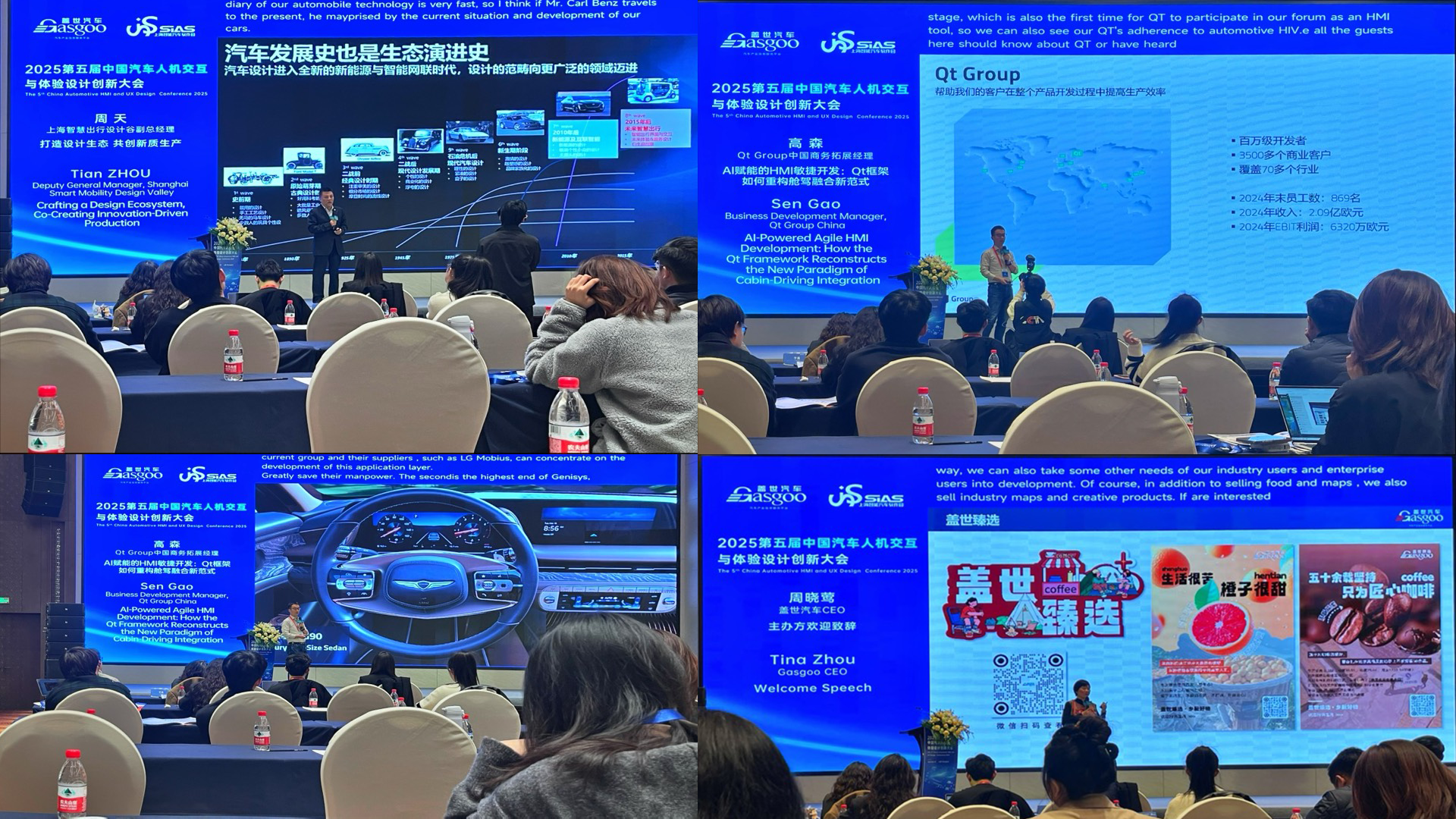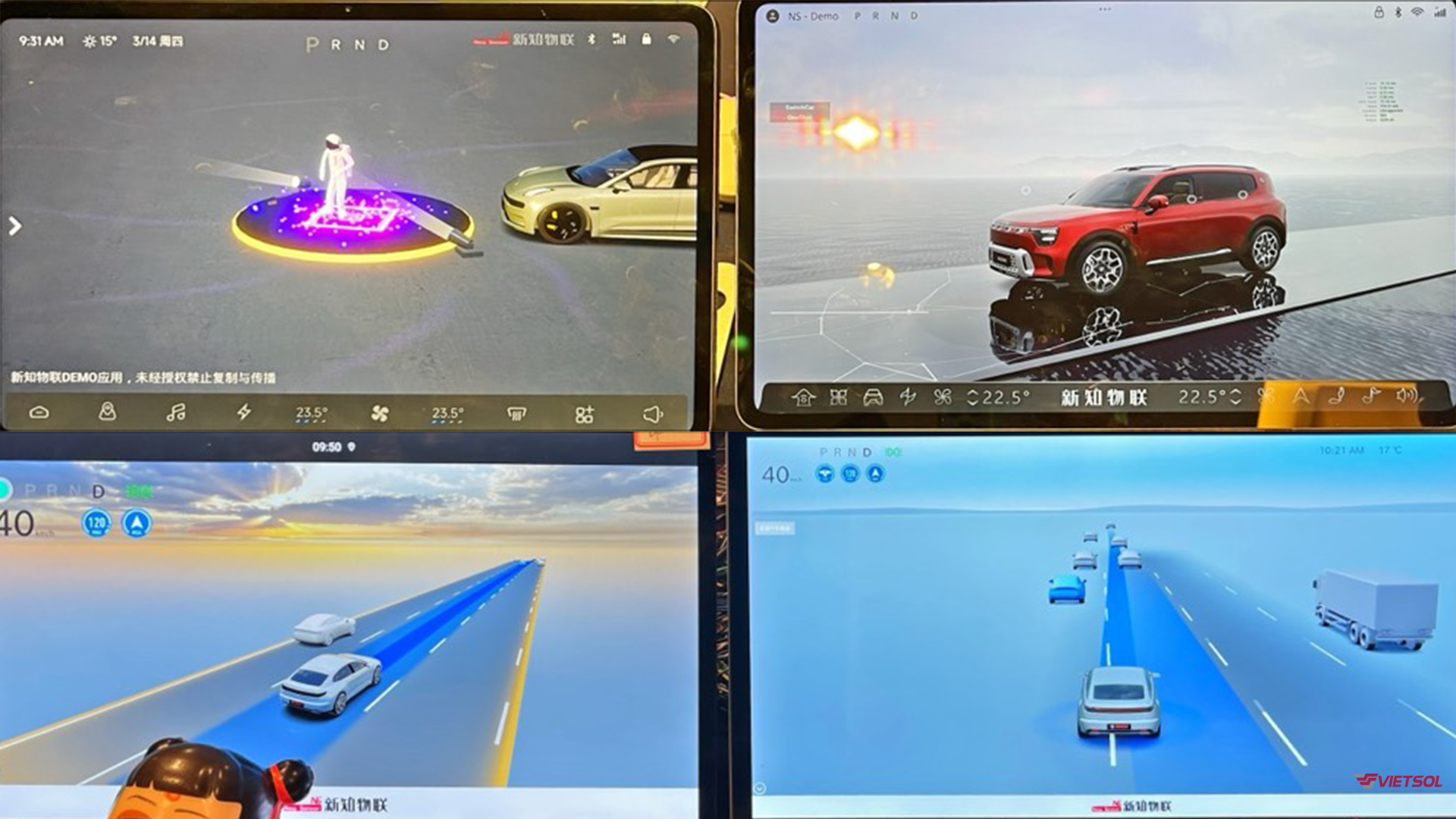Shanghai, March 2025 – “Attending the 5th Automotive UX & HMI Conference organized by Gasgoo was both eye-opening and affirming,” shared Mr. Ánh Trần, Head of UX/UI at Vietsol. “It’s clearer than ever that automotive UX is no longer just a visual enhancement. It has become a strategic differentiator that shapes how users feel, drive, and interact with technology on the road. From adaptive dashboards to gesture-controlled systems, the evolution of HMI is transforming the in-car experience into something far more intelligent, immersive, and human.”
The Gasgoo conference gathered global experts and forward-thinking companies — including Vietsol as a participating observer — to map out the next frontier of in-car interaction and understand emerging global best practices in Human-Machine Interface (HMI) development.
Gasgoo, founded in 2006, is one of the most influential automotive media and industry service platforms in China. Its annual UX HMI conference has become a flagship event for the Asian automotive tech ecosystem. It attracts leading OEMs, Tier-1 suppliers, design studios, software architects, and tech innovators, all coming together to discuss how vehicle-user relationships are being transformed in the digital age.
While Vietsol did not take the stage as a presenter, our presence through our Head of UX/UI provided a rare opportunity to network with peers, experience cutting-edge demos, and align our product vision with where the global market is heading. We walked away with not just notes — but new directions for innovation.
HMI: From Dashboard to Digital Ecosystem
In modern vehicles, Human-Machine Interface (HMI) design is the thread that ties together user comfort, safety, technology access, and brand identity. It is no longer limited to static dashboard layouts — today’s HMI is a living system that adapts in real-time.
Why It Matters:
A well-designed HMI makes critical features — such as emergency lane assist, battery efficiency modes, or driver fatigue alerts — more accessible, faster to interpret, and safer to interact with.
Gasgoo 2025 emphasized several evolving HMI pillars:
- Safety-first design: UI must minimize driver distraction while enabling full functionality. This requires intuitive layering, color-coded signal priorities, and interaction minimalism.
- Immersive cabin environments: Consumers now expect vehicles to behave like smart devices — with 3D dashboards, dynamic lighting synced to music, and AR HUDs as standard.
- Localization for user relevance:
- Europe/North America focuses on regulation-aligned minimalism, privacy-compliant interfaces, and conservative feature sets.
- Asia (esp. China) values multifunction dashboards, all-in-one super-app integration, and highly dynamic visual systems.
- New brands face the challenge of creating an identity distinct from Tesla, Nio, or Mercedes, avoiding visual mimicry while still meeting user expectations.
For Vietnamese OEMs or digital product partners, these lessons provide a clear roadmap: effective automotive UX design must be rooted in the cultural behaviors and digital habits of the local user — not just inspired by the West.

AI in UX: A Game Changer With Human Boundaries
One of the most exciting but also controversial discussions at Gasgoo was around the rapid adoption of AI in UX design for vehicles. AI today powers everything from proactive display layout changes to mood-based ambient lighting, but as Vietsol observed, it also opens new challenges.
Practical Use Cases (Automotive UX) Shared at the Event:
- Navigation routes that adapt based on learned user habits
- Voice commands personalized for dialect and tone recognition
- Music, lighting, and even seat posture adjusted based on detected mood or time of day
Yet with this intelligence comes the risk of over-automation. Key risks flagged include:
- Inaccurate voice interpretation during high-noise conditions
- AI systems failing to explain why decisions were made (lack of transparency)
- Drivers becoming too reliant on AI for tasks better suited for manual control
Key takeaway for Vietnam’s design community: AI is a powerful co-pilot, but never a full replacement for human-centered logic. UX needs clear fallback layers, user permission checkpoints, and transparency tools to build trust.
Technical Automotive UX Hurdles: Building Fast, Beautiful, Reliable UI
Gasgoo’s technical panels brought attention to the 5 foundational pain points that every team building automotive UX must solve. These are especially relevant for startups, B2B vendors, and design teams working on cross-platform embedded interfaces.
1. Multi-function Overload
The modern HMI must do everything: from climate to navigation, driver profiles to infotainment, and even smart home sync. This leads to clutter and confusion — an overloaded automotive UX that frustrates rather than empowers.
Guidance for Decision Makers: Consider modular architectures that break the UI into dedicated zones and allow task-based prioritization. Vietsol is exploring context-aware frameworks that hide less relevant modules based on driving mode or passenger profile.
2. High Fidelity vs. Hardware Constraints
Users want cinematic displays with weather effects, 3D maps, and rich animation. But GPU limits — especially in entry-level EVs — make this challenging.
Design Direction: Our strategy includes lightweight rendering engines (Qt 3D), pre-optimized shader libraries, and fallback visual states. For Vietnamese markets, where price-sensitive hardware is common, this approach allows scale without sacrificing experience.
3. Multimodal Interaction Design
Voice, gesture, physical buttons, and touchscreens all exist in parallel now. They must feel consistent and seamless — a true test for any automotive UX designer.
For Product Owners: Multimodal doesn’t mean redundant — it means cooperative. Vietsol is building interaction maps that account for cognitive load, and test across three languages (Vietnamese, English, Chinese) to ensure gesture or voice do not conflict.
4. Smooth Transitions and Instant Loading
Jittery or laggy interfaces break immersion and can frustrate users. This is not just a design flaw — it can create safety issues.
Solution Stack: Preloaded transitions, GPU-specific benchmarks, and failover animations are core to our QA process. We benchmark interaction latency under load, including poor LTE connection conditions.
5. Signal Complexity and Real-time Sync
The average EV today has over 100 ECUs and real-time data streams. Making sure the HMI is responsive to them all is a systems design nightmare — and a core challenge in reliable automotive UX implementation.
Development Frameworks: We support AUTOSAR middleware integration and use event-driven logic to manage competing signal priority. This is especially useful in fleet management, where diagnostics and safety flags must show immediately.

What’s Ahead: UX Trends Shaping the Next 5 Years
What comes after AI dashboards and AR HUDs? Gasgoo 2025 offered some provocative forecasts in how automotive UX will evolve
- Touchless control: Eye tracking and gesture-only dashboards for zero-touch experiences
- Deep personalization layers: Vehicles that sync with your smart home, schedule, and even your Spotify Discover Weekly
- Integrated safety nudges: Interfaces that nudge the driver based on health vitals (heart rate, blink frequency)
And here’s what we at Vietsol predict:
- Regional UX hubs will emerge to develop localized UI packs — not just translations, but behaviorally native systems
- Regulations will demand UX designers be trained in safety-first interface logic, not just aesthetics
- OEMs will start benchmarking UX responsiveness the same way they measure horsepower or charging speed
For Vietnamese innovators, this means one thing: we need to move beyond “making it work” and start leading the conversation on what thoughtful, culturally relevant, and delightful automotive UX can be.
Beyond the Conference: Vietsol’s Continued R&D
Armed with insights from Gasgoo 2025, Vietsol is accelerating our internal roadmap:
- Pilot testing gesture-based UI adapted for Southeast Asian user patterns
- Expanding our library of AI-driven UI behavior models with local datasets
- Partnering with OEMs for field-testing personalized infotainment experiences in Vietnam
We are also drafting a UX design whitepaper with key insights for OEM partners and hope to present it at future regional conferences.
Our vision: Position Vietsol as the leading UX innovation partner for future-ready automotive experiences in Southeast Asia.
Conclusion: From Feature to Philosophy
Automotive UX is no longer a cosmetic element. It is now a strategic tool that influences brand loyalty, driving safety, and user satisfaction.
From Shanghai back to Ho Chi Minh City, the message from Gasgoo 2025 was clear: to lead in mobility, we must lead in experience. Vietsol is committed to pushing this frontier — through thoughtful design, responsible AI, and regionally relevant innovation.
We invite our peers, clients, and fellow technologists to collaborate and co-create with us on this exciting journey.

 Tiếng Việt
Tiếng Việt
RELATED NEWS
Security Testing: The Essential Role in Automotive Cybersecurity
The explosive rise of interconnected automotive technologies is transforming the driving experience like never before. From seamless keyless entry and smartphone apps that control in-vehicle functions, to Vehicle-to-Everything (V2X) systems that enable cars to communicate with infrastructure, other vehicles, and real-time data sources — today’s vehicles are smarter, safer, and...
What are Driver and Occupant Monitoring Systems (DMS/OMS)?
In the automotive industry, many safety incidents originate from human factors inside the vehicle cabin, such as driver distraction, drowsiness, or passengers not wearing seat belts. As a result, in-cabin monitoring and proactive responses to abnormal behaviors are becoming increasingly essential. The Driver Monitoring System (DMS) and Occupant Monitoring System...
Welcoming Didier Chenneveau as Senior Strategic Advisor to Vietsol – Driving Global Strategy in Edge AI and Mobility
Vietsol is proud to announce the appointment of Mr. Didier Chenneveau as Senior Strategic Advisor, marking a significant milestone in our mission to become a globally competitive engineering and technology company. With over 35 years of global leadership experience, Didier will play a key role in shaping Vietsol’s international strategy,...